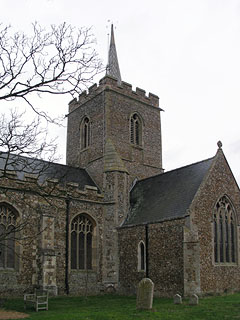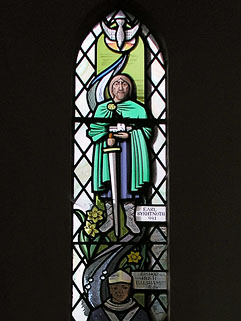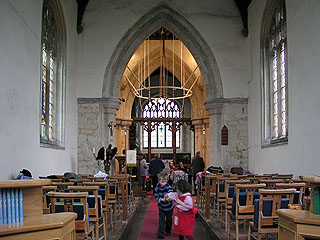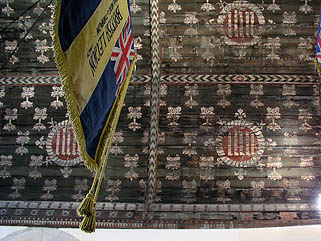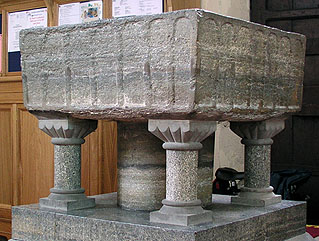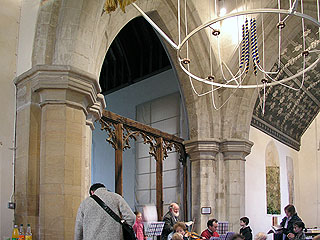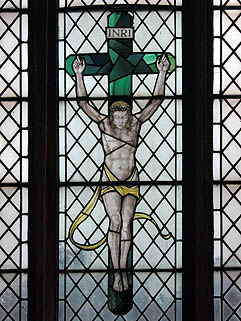Gehyrst þu, sælida, hwæt þis folc segeð?
It is 991, and we are watching two armies face each other over the salt marshes near Maldon, in Essex. A large force of Vikings has landed on an island, and they have just sent a messenger to the small force of Saxon defenders offering to leave in exchange for tribute of gold and silver.
The leader of the Saxons, though, is Byrhtnoth, Ealdorman of Essex - a proud and stubborn man. He sends the messenger back with the haughty rejection whose first line you can see above - here's a translation of the rest of it, taken from the glorious Old English poem known as The Batle of Maldon:
Hear now you, pirate, what this people say?
They desire to you a tribute of spears to pay,
poisoned spears and old swords,
the war-gear which you in battle will not profit from.
Sea-thieves messenger, deliver back in reply,
tell your people this spiteful message,
that here stands undaunted an Earl with his band of men
who will defend our homeland,
Aethelred's country, the lord of my people and land.
Byhtnoth's band might have been outnumbered, but they were in a strong position - the mainland could be reached only by a narrow causeway, and for a while three of his men were able to hold back the entire Viking force. The Vikings sent another message complaining that they weren't being given a fair fight and Byrhtnoth responded by pulling them back. Stupidity, or self-sacrifice? I was inclined to think the former, but a couple of friends pointed out to me that had Byrhtnoth not engaged the Vikings there, they would have left and probably put to land somewhere completely defenceless. As it was, the defence cost the English dearly - the Earl and all his thegns were slaughtered. Byrhtnoth never did return home from that dark strand.
Where was his home? It's just possible that he might have come here, to Thriplow, in the hills between Essex and Cambridgeshire. This was one of his manors, left after his death to the great Anglo-Saxon Abbey of Ely. Later, when the Abbots of Ely had become the Norman Bishops and Hugh de Balsham sat in the cathedra, the Rectory of Thriplow was granted to the Masters and Scholars of Peterhouse, Bishop Hugh's new establishment at the youthful university of Cambridge. And so, the great institutions of the county wind their way through the history of this parish - but for all that, it is a more ancient place than college, or cathedral, or church.
The hill is exposed, the highest point for several miles around. Just to the south of the churchyard there was a big tumulus where in 1953 they found the burial site of a chieftain, laid to rest 3,500 years ago. Later peoples added more burials here, and eleven cremations from the later Bronze Age have been discovered clustering around the hilltop. Back then, it was faced with gleaming white chalk - a landmark for people travelling along the Icknield Way, the prehistoric track which runs from Ivinghoe Beacon in Buckinghamshire up to Knettishall Heath in Norfolk.
The hill at Thriplow was a holy place long before Byrhtnoth left on his fateful journey to Maldon, then - long before the Saxon Trippa came, and was buried under his own mound (a Law) giving his name to the village. Trippa-Law, Thriplow - interesting, though, that it is still pronounced with a hard 't' sound. The English land and the English language twine together - to paraphrase Paul Theroux, this is an island filled with words and the ghosts of words.
There is a story here that the first church was not supposed to be built on this hilltop, haunted by ancient shadows under the Law . There is a pleasant meadow down the hill, now behind the School, and they started to build there. Every time they began, the Devil would come and tear up the foundations. The old high places have their prerogative, and so St George was raised here.
The oldest parts of the church are from the 1100s - some signs of this can still be seen outside on the north transept. Most of the structure we see today, though, is late 13 th century Decorated, with Perpendicular windows inserted. The present structure betrays its Norman roots in its shape - a great cross-shape, with a stocky tower and a tall, thin nave. The plan is not so uncommon in this part of Cambridgeshire, but the church at Thriplow is not so delicate as Ickleton down in the valley of the upper Granta, nor as richly decorated as Fowlmere in the next parish. St George was built as a sanctuary, and a fortress against the storming skies and the raging ghosts.
We found it a sanctuary, too - on the day we visited the heavens were a great battle of winds and rain and towering clouds. Inside, though, St George was all light - and music, too, for we arrived in the middle of a rehearsal for the family service taking place the next day. We had a few bemused looks, but they seemed quite happy for us to explore while they played, and so we were able to stomp around while they sang 'Oh When the Saints Go Marching In' and 'All Things Bright and Beautiful' to the accompaniment of electric guitar and a surprisingly good 10-year-old trumpet player. The younger children played tambourines, or marched up and down the nave being the aforementioned saints.
There was a churchwarden providing the bass part who was torn between music and his evident love of the church - in the end the latter won because he came and showed us some of the best bits. There's a lot to see here, too. The crossing is a particularly handsome space - the arches are lofty enough that the vistas through the church aren't blocked, as is the case in some other cruciform churches, and they are a particularly elegant shape. It's all built in clunch, save for the eastern pier of the north arch, which is of sandstone. The churchwarden told us that this was characteristic of George Gilbert Scott, who restored the church in the 1870s - apparently he was unable to (or refused to!) tell the difference between the two stones.
The Victorian restoration also gave painted roofs to the nave and the south transept. The former is very nice, though I wasn't very fond of the latter. The north transept roof is older, and only needed retouching by the Victorians - it's also the best, in my opinion - a design of sunbursts containing the sacred monogram 'IHS'. The restoration, besides rebuilding the porch and redoing the east window, was remarkably understated.
The most visible remainder is the splendid Purbeck marble font, which had been hidden in the south-west corner until the restorers uncovered it and placed it in its current location. The finest fitting in the church will probably, by now, have caught your eye. This is the chancel screen - a triple arcade in oak, dating from about 1350. The original tracery was mutilated by Dowsing: subsequently the tracery in the three great lights has been replaced, but it still seems remarkably open by comparison to the denser Perpendicular screens that we see more often in the county, compounded by it having lost its dado panels. In the literature, there is some confusion about this screen. The shorter guide suggests that it was originally further forward, in front of the western tower arch. This would line up with the rood stair.
Nevertheless, it would be very strange for the rood screen to cordon off not only the chancel but also the transepts. The longer guidebook (which is, incidentally, one of the best I've seen - it was written by Geoffrey Viner, J.P., who is commemorated in one of the windows) agrees that this is only a fragment of the original, but also says 'the pieces of the screen now remaining were made for its present position'. Perhaps there was both a rood screen and a chancel screen? This would fit with the final piece of evidence: when in 1518 they were erecting a rood screen at St Mary the Great in Cambridge, they stipulated that:
'the briste of the sayd new rodde lofte schal be after and accordying to the briste of ye rodde lofte within ye parisshe chirche of Triplow in all manner housings, fynyalls, gabeletts, formes, figures, and rankenesse of worke, as good or better in every poynte.'
As Mark asked, would the burghers and scholars of Cambridge, adorning their magnificent new church, really want to copy a screen that was over a century and a half behind the fashion of the times? Well, perhaps - it is difficult to speculate without seeing the screen in its full glory. Whether the current fragment is a remnant of that great screen or not, it must have been quite spectacular.
In the south transept, a fragmentary statue-niche survives - the bracket has been hacked off, and the niche itself almost flattened, but enough of the vaulting survives to give an idea of what it must have been like. A little bit of red paint clings to the plaster, both here and in the window next to it. The south transept also contains the doorway to the tower stair. The north transept contains a rather crude wall monument to Edward Lucas, a London merchant who died in 1601. Next to it is a window with modern glass depicting Bishop Hugh de Balsham and our imprudent friend Earl Byrhtnoth.
There's also some good glass in the east window - a modern image of Christ on the cross. The figure is slightly stylised, with the end of the loincloth sweeping behind him in an art-deco curl. The feel of it, though, is reminiscent of William Blake, and rather disturbing - the tiny figure hanging in the middle of the window, head facing straight down, eyes closed in pain and surrounded by a great void of clear glass. We looked up, and stormy light glinted through and around the fragile form. The wind was rising, and the musicians were packing up - it was time to leave the sanctuary, and run for home.
Mark adds: In November 2004 we received a lovely email from Shirley Wittering (who rejoices in the splendid title of Chairman of the Thriplow Society) which supplies a few more details about this church:
"The church was dedicated to 'All Saints' until the Puritans decided saints were out. It had a Guild of the same name and many early wills (copies of which I have) mention it by name. The name St George was not mentioned until 1852. Wm Dowsing visited in 1644 and there is a Graffitto on the buttress on the south wall of the nave, perhaps put there by John Lill, it is just at the right height that a man on horseback could scratch in the stone. Wm Cole from Milton visited twice, first in 1742 and left a good description of the windows and brasses etc. There is a month by month description of the restoration in 1875-7 in the parish magazine of the time. This has been reprinted in the Thriplow Journal Vol. 3/2, 1995. (Copies of these are kept at the Cambridgeshire Collection). The Millennium window was the brain-child of myself and Peter Speak (then Chairman of the Thriplow Society) and the money was raised by the Thriplow Society and the people of the village."
St George was open when we visited.
